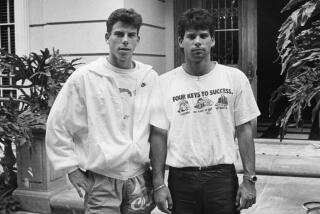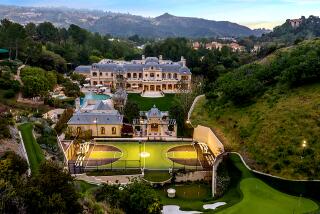Westside mansion sells for $102 million, highest Southland price
After an international bidding war, a Westside mansion often described as a French palace has changed hands for $102 million, making it the most expensive residential sale ever recorded in Southern California.
As is often the case with high-end properties, the identity of the trophy home’s unnamed buyer has been obscured behind layers of lawyers, agents and a limited liability company.
But the real estate equivalent of a bread crumb trail suggests that the purchaser of the opulent estate is onetime junk bond king Michael Milken, who has spent more than two decades devoted to philanthropic efforts since he pleaded guilty in 1990 to securities fraud.
The 50,000-square-foot residence was named Fleur de Lys by the seller, socialite Suzanne Saperstein. She had the mansion custom built a dozen years ago with her then-husband, Metro Networks founder David Saperstein. They divorced three years after work was finished, and she first listed the property in 2007 at the peak of the L.A. County real estate market for $125 million.
She took it on and off the market several times, almost selling it at one point to British heiress Petra Ecclestone, who ended up buying Candy Spelling’s nearby spread for $85 million.
The buyer was initially identified as a French billionaire who paid all cash and closed in 10 days. But a copy of the grant deed obtained by The Times shows that the taxes will be mailed to the Santa Monica headquarters of the Milken Institute, the nonpartisan think tank founded by Milken in 1991.
The buyer is listed as FDL Property, a limited-liability company registered in Delaware and represented by the law firm of Maron & Sandler, which is based in the building that houses the Milken Institute.
Maron & Sandler partner Richard V. Sandler is executive vice president and a trustee of the Milken Family Foundation and a director of the Milken Institute. Sandler is the finance legend’s longtime friend and lawyer — and his employer in 1993 after Milken emerged from 22 months in a minimum-security prison.
The buyer was represented by Fred Bernstein of the Westside Agency. Bernstein is married to Milken’s daughter, Bari.
The Milken camp denied the purchase. Milken spokesman Geoffrey Moore said in an email that he was unable to reach Milken, who was traveling, but “I did a quick check and can tell you that neither Mike Milken nor the Milken Institute is the purchaser.”
The sale fails to eclipse the U.S. record set last year when a mansion on nine acres in the Northern California community of Woodside went for $117.5 million. That deal may have included other considerations because the buyer and seller are business partners.
The transaction does beat the long-held local record established in 2000 when Dole Food Co. billionaire David Murdock sold a Bel-Air property to financial executive Gary Winnick in a $94-million deal that involved a parcel of land in trade.
This affluent Westside stretch of Holmby Hills, Bel-Air and Beverly Hills, known as the Platinum Triangle for its wealthy residents and top-dollar properties, was ripe for a home sale of such magnitude.
“This is one of the greatest estates in Los Angeles, if not the country,” said Kurt Rappaport of Westside Estate Agency, who represented Saperstein in the sale.
The house is in the Holmby Hills area, a sweet spot for opulent homes with neighbors including entertainment mogul David Geffen, Microsoft Corp. co-founder Paul Allen and actress Sandra Bullock.
Real estate experts say L.A. prices seem like bargains compared with home prices in other major cities — particularly to foreign buyers willing to pay cash. The other bidders on Fleur de Lys were identified as English and Chinese billionaires.
Adding to the competition for such trophy estates is the fact that the Los Angeles-area housing supply is constrained by its geography, said economist Gary Painter, director of research for USC’s Lusk Center for Real Estate. In this built-out environment there are few estates with acreage from which to choose.
“This is a very thin market, in a similar vein to an art market,” Painter said. “There’s only one of that type.”
Housing analysts, however, are seeing more sales at the upper-price tiers. DataQuick reports sales volumes are up by about a third in the $5 million and more slice of the market so far this year compared with the first three months of last year. From the August 2007 peak of the overall market, according to February statistics, prices are still down 22.5%.
“The luxury market isn’t as tied to job and income growth and mortgage rates,” said Andrew LePage, an analyst with DataQuick, a real estate research firm. “It’s more about stock market performance, IPOs, competing investments, where people want to park their extra money and foreign investment.”
Completed in 2002, the compound stretching between Carolwood and Angelo drives was years in the making. Purchasing the adjacent parcels that make up the estate took about five years, and several more years were spent in various stages of construction.
Wrought-iron gates open to a 600-foot-long tree-lined driveway that leads to a cobblestone courtyard in front of the house. The granite stones were salvaged from the streets of Manhattan when the sewer system was being redone, said architect Richardson Robertson III, whose L.A.-based Robertson Partners designed the formidable estate.
Just inside the front door is a two-story entry hall with a marble floor topped by a gold-leaf paneled ceiling. A pair of staircases lead upstairs, and a doorway flanked by columns looks out to the backyard and gardens.
Although sometimes described as having been inspired by Vaux-le-Vicomte, a palace outside Paris, the mansion took its cues from great estates in Newport, R.I., Robertson said. “This is not a French floor plan. It’s a neoclassical house built as a decorative arts museum.”
The grounds have been likened to a miniature Versailles with formal gardens, mature trees and a soccer-field-size expanse of lawn. The 4.9 acres include two motor courts, a swimming pool and spa complex, and a tennis court. A jogging track runs inside the perimeter of the property.
Imported limestone blocks enclose a massive steel frame, set on rollers in the foundation, to safeguard the structure in an earthquake. Interior spaces include a ballroom for 500 guests, a two-story wood-paneled library, a movie theater, a music room, a dance studio, a beauty salon, a dozen bedrooms and 15 bathrooms.
Service spaces include a commercial kitchen, a room for the cutlery and dishes, a butler’s pantry, a staff dining room, staff offices and a security center.
The 3,000-square-foot wine cellar and tasting room is larger than most American houses, as is the manager’s house.
Those who have never set foot in the palatial estate may have had an unknowing glimpse on television or at the movies. Parts of it were used for the ABC drama “Big Shots” (2007-08), Super Bowl 2008 Audi commercials and the 2011 film “The Green Hornet.”
Others were able to purchase a piece of the estate two years ago when Sotheby’s auctioned Saperstein’s antique French furniture. The more than $8 million in sales included a 21-light German chandelier from the 1700s that brought about $602,500.
Twitter: @LATHotProperty







